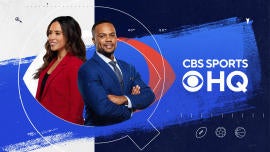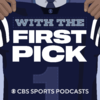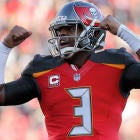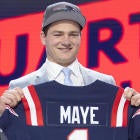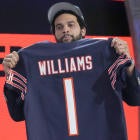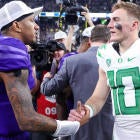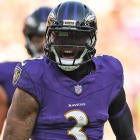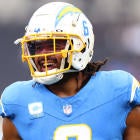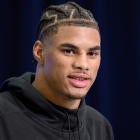From top to bottom, the NFC South might be the NFL's best division. It put three teams in the playoffs last season and the Saints were one ridiculous game-deciding play away from going to the NFC Championship Game. In 2016, the Falcons were one forgettable fourth-quarter away from their first Super Bowl title. And the year before that, the Panthers went 15-1 and made it to the Super Bowl where they lost to the Broncos.
Which means that this is the Buccaneers' year, right?
We're not willing to crown them kings of the conference just yet but they could be one of the surprise teams of 2018 -- even in a division as competitive as the NFC South.
OK, let's get go it. We'll start in Atlanta.
 Atlanta Falcons
Atlanta Falcons
- Key additions: TE Logan Paulsen, CB Justin Bethel, RG Brandon Fusco
- Key losses: DE Adrian Clayborn, DT Dontari Poe, WR Taylor Gabriel, TE Levine Toilolo
- Key rookies: WR Calvin Ridley, CB Isaiah Oliver, DT Deandrin Senat
Somehow, the Falcons were the NFC South's forgotten team last season. They qualified for the playoffs via a wild-card spot, and even won their first-round game against the upstart Rams. But their 2017 campaign ended in the divisional matchup against the Eagles. A year before, Atlanta was on its way to the Super Bowl where it was some 20 minutes away from the franchise's first-ever Lombardi Trophy. Instead, things went horribly wrong down the stretch and, well, let's just say the Patriots got another well-deserved title.
The Falcons' were inconsistent during the first half of the '17 season, in part because the transition from offensive coordinator Kyle Shanahan to his replacement, didn't go as smoothly as hoped, but the offense still finished among the top 10, according to Football Outsiders' metrics.
Perhaps it says something about the depth chart that the team wasn't active in free agency, and the fact that the front office and coaching staff passed on a much-needed defensive lineman with their first-round pick says even more about their collective mindset heading into '18. Even with Julio Jones and Mohamed Sanu, who combined for 155 receptions and 2,147 yards last season, the Falcons took Alabama wide receiver Calvin Ridley with the No. 26 pick.
That gives Matt Ryan, who recently signed an NFL-record $150 million deal, yet another target. In addition to Jones and Sanu, Ridley joins tight end Austin Hooper (49 receptions), and running backs Devonta Freeman (36 receptions) and Tevin Coleman (27 receptions). Combine playmakers at every level with an offensive line that ranks among the top 10 in both run blocking and pass rushing, and it's easy to make the case that the team that represented the NFC in the Super Bowl in 2016 could be among the favorites to do it again this season.
How much this defense improves will ultimately decide how far Atlanta goes. In '16, the unit ranked eighth in the league and proved too fast and too physical for the Patriots for nearly three quarters of Super Bowl LI. Last season, however, the group fell to 22nd and were equally ineffective against the run and the pass (they ranked 20th in both categories).
Third-round pick Deadrin Senat is a run-stuffing defensive tackle and he fills an obvious need after Dontari Poe left in free agency. Second-rounder Isaiah Oliver joins a talented secondary that includes Desmond Trufant, Robert Alford, Ricardo Allen and Keanu Neal. Oliver, who is listed at 6-1, 200 pounds, has drawn comparisons to Richard Sherman. Given coach Dan Quinn's ties to Seattle, it makes sense that the Falcons would be interested.
Offseason grade: B-
 Carolina Panthers
Carolina Panthers
- Key additions: RB C.J. Anderson, WR Torrey Smith, WR Jarius Wright, DT Dontari Poe, S Da'Norris Searcy
- Key losses: OG Andrew Norwell, RB Jonathan Stewart, S Kurt Coleman, DE Charles Johnson, DT Star Lotulelei, TE Ed Dickson
- Key rookies: WR D.J. Moore, Rashaan Gaulden, TE Ian Thomas
The Panthers' biggest offseason need was wide receiver and it's one they addressed early and often, starting in free agency with Jarius Wright and Torrey Smith, and again in the first round of the draft with D.J. Moore, who was not only the first wideout taken in 2018 but arguably the biggest downfield playmaker too.
For an idea of just how explosive Moore can be, here are 12 seconds from the 2016 season that went a long way in convincing the Panthers that he was a worth first-round selection:
Trust me: Do yourself a favor and watch this D.J Moore @TerpsFootball touchdown. https://t.co/x9d3yTTyVP
— Brent Yarina (@BTNBrentYarina) November 19, 2016
Even Retired Panthers legend Steve Smith loved the addition of Moore, going so far as to say, "They have never been able to replace me ... until today."
A season ago, rookie running back Christian McCaffrey was the team's leading receiver (80 catches) followed by wideout Devin Funchess (63) and Kelvin Benjamin (51), who was traded midway through the season. McCaffrey and Funchess remain, but the workload will be spread among newcomers as well as 33-year-old tight end Greg Olsen, who missed nine games last season with a broken ankle. Adding depth behind Olsen is rookie tight end Ian Thomas, who will fill the hole left by Ed Dickson (and his 30 receptions).
Expect McCaffrey's role to grow in '18; he had 651 receiving yards but just 435 rushing yards, which was third on the team behind quarterback Cam Newton (754 yards) and since-released Jonathan Stewart (680 yards). Also helping an already good running game: The Panthers signed C.J. Anderson, who is four years younger than Stewart and rushed for 1,007 yards with the Broncos last season.
On defense, the Panthers lost former first-round pick Star Lotulelei but replaced him with another first-rounder, Dontari Poe. The team also signed safety Da'Norris Searcy after letting Kurt Coleman walk (he's now with the Saints) and he and third-round pick Rashaan Gaulden will battle for playing time.
Offseason grade: B+
 New Orleans Saints
New Orleans Saints
- Key additions: WR Cameron Meredith, S Kurt Coleman, CB Patrick Robinson, ILB Demario Davis, TE Ben Watson, QB Tom Savage
- Key losses: TE Coby Fleener, OT Zach Strief, QB Chase Daniel, S Rafael Bush
- Key rookies: DE Marcus Davenport, WR Tre'Quan Smith
In the weeks leading up to the 2018 NFL Draft, the speculation was that the Saints might take a quarterback -- like, say, Lamar Jackson -- or perhaps even a tight end. Instead, they traded up from No. 27 to No. 14 to take ... edge rusher Marcus Davenport.
Maybe New Orleans deserves the benefit of the doubt. A year after having the NFL's best draft class -- it included Marshon Lattimore, Ryan Ramczyck, Marcus Williams and Alvin Kamara -- the Saints knew pass rusher was a need, and they identified Davenport as their guy.
We'll all have to wait and see together whether this was the right move. From the perspective of late May, it's tough to get over the idea that passing on Jackson will come back to haunt them. Drew Brees is 39 and while his game doesn't appear to be slipping, he ain't playing forever. That said, if the Saints are in win-now mode, finding a pass rusher for 2018 makes more sense than drafting Brees' eventual replacement, who might not even see the field for another couple seasons.
New Orleans also has a good track record with taking defensive players in Round 1 as evidenced by the '17 draft haul. The unit ranked eighth last season after finishing 26th in 2016 and dead last in 2015.
Offensively, the Saints have the NFL's third-ranked quarterback (Brees), the third-ranked running back (Kamara), and the second-ranked wideout (Michael Thomas). There's also running back Mark Ingram, who will return to the fold after serving a four-game suspension to begin the season. Meanwhile, Coby Fleener is gone after two seasons and replaced by veteran Benjamin Watson. The team signed Cameron Meredith, the Bears' best receiver in 2016 who suffered an ACL injury and missed all of '17. The Saints also used its third-round pick on wideout Tre'Quan Smith, who could eventually develop into a No. 2 receiver opposite Thomas.
If Davenport doesn't show immediate dividends and the Saints' pass rush struggles, critics will question whether quarterback would have been a better long-term choice. We won't know the answer to those questions for at least several months.
Offseason grade: C+
 Tampa Bay Buccaneers
Tampa Bay Buccaneers
- Key additions: DE Jason Pierre-Paul, DE Vinny Curry, C Ryan Jensen, DT Beau Allen, K Chandler Catanzaro
- Key losses: RB Doug Martin, DT Chris Baker, DE Robert Ayers,
- Key rookies: DT Vita Vea, RB Ronald Jones, DB M.J. Stewart, CB Carlton Davis
Notice a theme? A season ago the Bucs ranked dead last in sacks (22), which resulted in the league's 31st-ranked pass defense. The 19th-rated run defense wasn't much better. So it stands to reason the organization would spend the offseason upgrading that side of the ball. They started with the pass rushers, signing Vinny Curry to a three-year deal and trading for Jason Pierre-Paul. Tampa Bay cut defensive tackle Chris Baker, but signed Beau Allen, who will add depth behind first-round pick Vita Vea.
Some draft experts expected the Bucs to target a defensive back in Round 1 but they addressed those needs in later rounds.
"I know there are plenty of folks out there that thought we were gonna go with a DB with this pick," coach Dirk Koetter said shortly after the team took Vea, "but we have to get better on defense either way. Whether you're putting pressure on the quarterback and stopping the run or whether you're covering receivers better, they're both positives. And we also picked up some picks so we can address some of our other needs."
Those picks include defensive back M.J. Stewart, who can play safety or nickel back, and Carlton Davis, a physically imposing cornerback (6-1, 206 pounds) who excels in coverage but struggled with pass-interference flags during his junior season at Auburn.
On the other side of the ball, the offensive line was replacement level in both run blocking and pass protection, and offseason acquisition Ryan Jensen immediately upgrades the center position. The Bucs used a second-round pick on USC back Ronald Jones, who replaces Doug Martin on the roster and will share carries with Jacquizz Rodgers.
Ultimately, any success the Bucs have will come down to quarterback Jameis Winston. In 2017, he set career highs in completion (63.8), yards per attempt (7.9) and passer rating (92.2), and ranked 11th in total value among all quarterbacks, just behind Matthew Stafford and Alex Smith. But Tampa's 11th-rated offense couldn't overcome the league's worst defense, hence the 5-11 record. But with Winston, an upgraded running game, and downfield playmakers DeSean Jackson, Mike Evans, Adam Humphries, Cameron Brate and O.J. Howard, the Bucs could be one of the biggest surprises of the 2018 season. Remember: The team finished 9-7 in 2016 with the 19th-rated offense and the 13th-rated defense. If the Bucs' offense replicates last year's success (and there's no reason to think they won't improve on it), and the defense can just be a replacement-level unit, the playoffs are a realistic possibility.
Offseason grade: A


